I finally made it back to Cádiz.
For years, it lingered in the back of my mind. My first and only visit was over a decade ago. Since then, I’ve returned to the surrounding province many times, drawn to the powdery beaches of Tarifa and Bolonia and their blissfully cool summer air. But I never made it back to the capital itself. Until now. After this trip, I can’t help but wonder what took me so long.
Perched on a narrow slice of land jutting into the Atlantic, this sun-drenched city is almost entirely surrounded by water. It’s the capital of Cádiz province, a region beloved by Spaniards for its wild beaches and wind-swept dunes along the Costa de la Luz. Unlike the crowded, built-up resorts of the Costa del Sol, this is where Andalusians come to escape the heat.
With its pastel buildings, a cathedral gleaming over the sea, and a breezy, palm-lined promenade, it’s no wonder people have nicknamed it "Little Havana." But Cádiz doesn’t need to borrow charm—it stands firmly on its own, with a culture that feels entirely unique.
Get Your Free Spain Report Today!
Get Your Free Spain Report Today!
Learn more about the lower cost of living in Spain and other countries in our free daily postcard e-letter. Simply enter your email address below and we'll also send you a FREE REPORT — Live the Good Life in Sunny, Affordable Spain.

By submitting your email address, you will receive a free subscription to IL Postcards, The Untourist Daily and special offers from International Living and our affiliates. You can unsubscribe at any time, and we encourage you to read more about our Privacy Policy.
When I came here in 2008, it was for a quick Semana Santa (Holy Week) getaway from Madrid. Back then, Cádiz struck me as a quiet escape from the hustle and bustle. To my surprise, that sense of stillness hasn’t changed a bit.
In a country that sees more tourists than nearly anywhere else on Earth, it’s rare to find a city that still feels untouched, at least by Americans. Cádiz has long been a summer escape for Spaniards and the occasional European, but English is scarce here. What you get instead is a city that still feels unmistakably Andalusian, with a cost of living under $2,000 per month for two people.
That’s exactly what pulled me in. I didn’t come to Cádiz just to check it off a list. I wanted to understand what it might feel like to make a life here… in a place that’s beautiful and affordable, yes—but also slow-paced, rooted in tradition, and wonderfully authentic. So, I packed my bags…
Insider tip: Catch a glimpse of historic Cádiz with a climb to the top of Torre Tavira—the former lookout tower offers one of the best views in town.
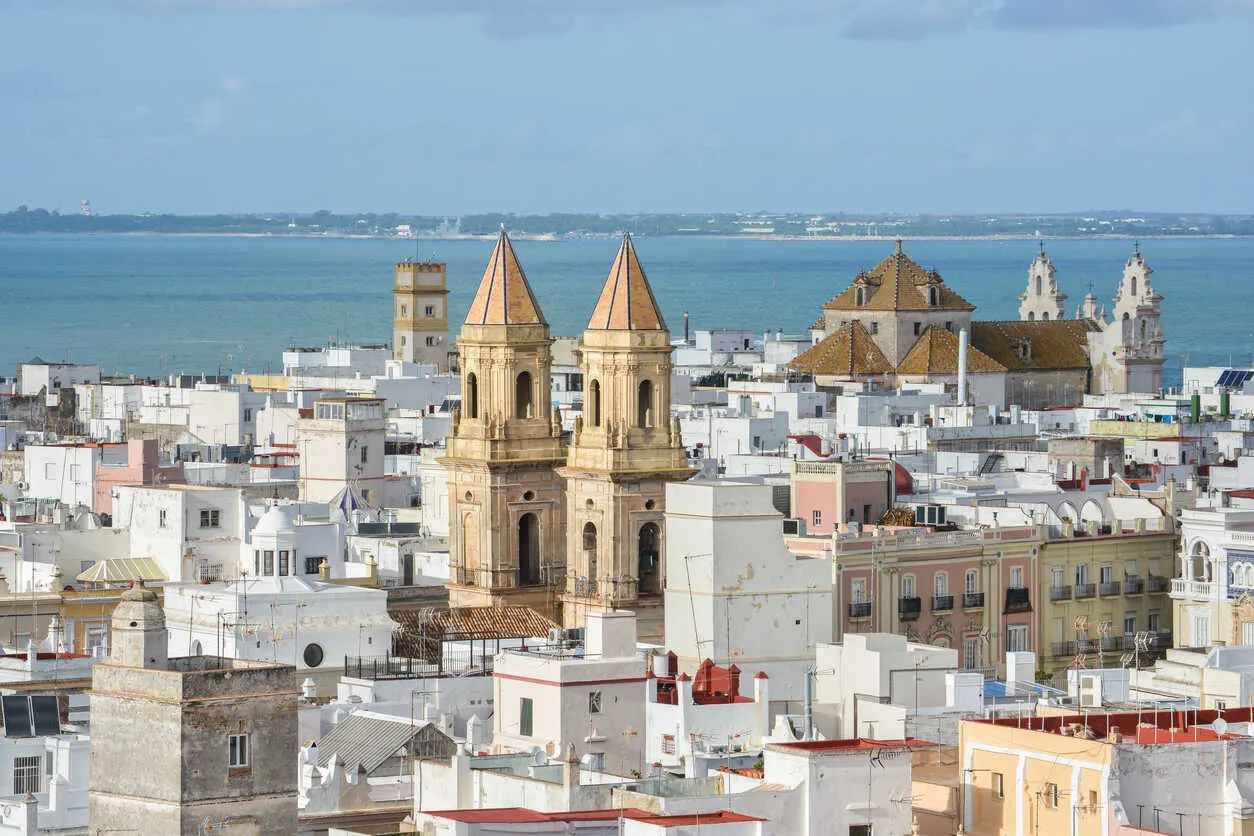
Remnants of the Past: A City Shaped by its 3,000-Year History
A defensible near-island with excellent access to trade routes, the city was founded around 1100 BCE by Phoenician traders who named it Gadir. The Greeks and Carthaginians came next; Hannibal himself is said to have launched his legendary campaign from here. Under the Romans, it became Gades, which is why today you’ll hear locals refer to themselves as gaditanos. Remnants of temples, aqueducts, and even a Roman theater still peek through the modern-day city.
After the fall of Rome, Cádiz passed through the hands of Visigoths and Byzantines before the Moors took over in 711 CE. Renaming it Jazīrat Qādis, they left their mark in the old town’s narrow, shaded alleyways—cleverly designed to keep the summer sun at bay.
In 1262, Alfonso X of Castile reclaimed the city, integrating it into Christian Spain.
By the 18th century, Cádiz had monopolized trade with the Americas. With new wealth came grand baroque architecture, merchant mansions, and watchtowers that still rise above the skyline.
Today, Cádiz is a small city with a shrinking population (just over 110,000) and its charm lies in what hasn’t changed. The original skyline is protected—by law, no building in the old town can stand taller than the cathedral. And while there’s a newer section of the city, it hasn’t been swallowed by luxury condos or glossy developments. Cádiz remains refreshingly itself.
Daily life in Cádiz is shaped by its stunning natural setting and deeply rooted local culture. The city’s waterfront promenades invite residents to live outside. Strolling along the Playa Victoria, surfing, hiking, and dining al fresco are part of everyday life. The relaxed beach-town atmosphere encourages slowing down and disconnecting.
That easy pace, along with the natural beauty and ocean views, has long attracted creatives. Local artists often draw inspiration from the golden-hour glow that blankets the old town, the curve of the bay, and the everyday scenes of coastal life. I stumbled upon a tiny studio by the artist Sara Ochoa and nearly walked out with a painting of a Playa de la Caleta sunset, but in the end, I couldn’t figure out where I’d hang it. So I saved my wallet… and my walls. The Omorfia Art Gallery also showcases local talent in rotating exhibits.
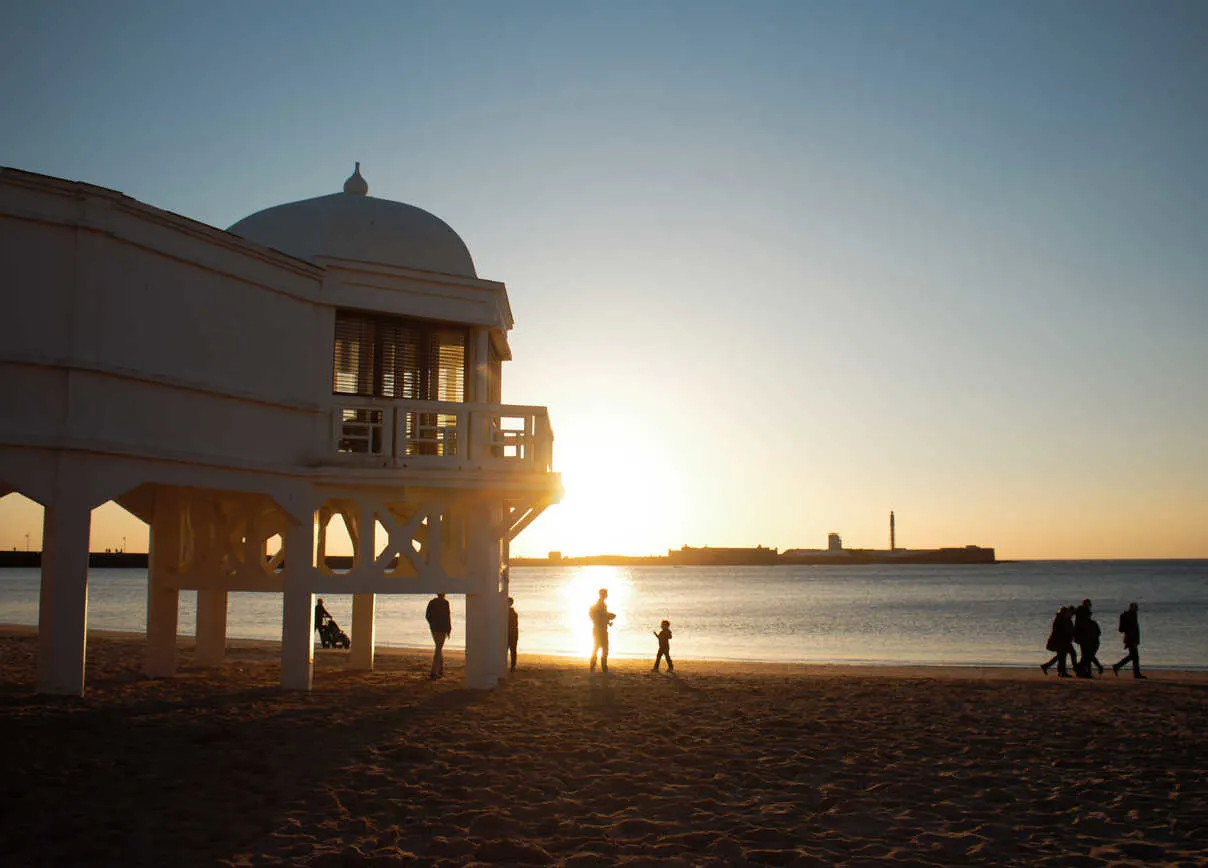
Once a fishing town, its lively heritage remains visible in bustling markets and a strong tradition of fresh seafood. You’ll see it in the daily catches hauled into the Mercado Central de Abastos, where locals haggle for just-caught tuna. It’s best to go before 2 p.m., when most vendors start packing up for the day.
Prefer to eat out? Casa Lazo is a no-frills, traditional Spanish restaurant known for its unfussy, delicious fish dishes. The owner, Eduardo, took our order himself and insisted we try the grilled sea bream for two. It was perfectly charred, flaky, and full of flavor. But the real surprise was the papas aliñás, a humble dish of cold boiled potatoes doused in olive oil and vinegar, with slivers of onion on top. Simple, but so good we were practically fighting over the last bite, and all washed down with a glass of Barbadillo, a local white wine. Book ahead and plan to linger over a long, late lunch—just like the gaditanos do.
The plazas buzz with locals of all ages throughout the day and into the night. With about 25% of the population over 65, there’s a tight-knit community feel, but don’t expect the city to quiet down early. Dinner here typically starts around 9:30 or 10 p.m., as is tradition across Spain.
Cádiz is famous for its sharp wit and humor, too. Locals are often called the funniest people in the country.
Locals are warm and welcoming to expats, and the unique gaditano dialect adds charm to everyday conversations. Terms like Cai (a loving nickname for Cádiz) and quillo or quilla (masculine and feminine versions of a term of endearment) are peppered into daily speech. I even heard guachisnai, a playful word for English-speaking foreigners that’s said to come from the phrase "What’s your name?"
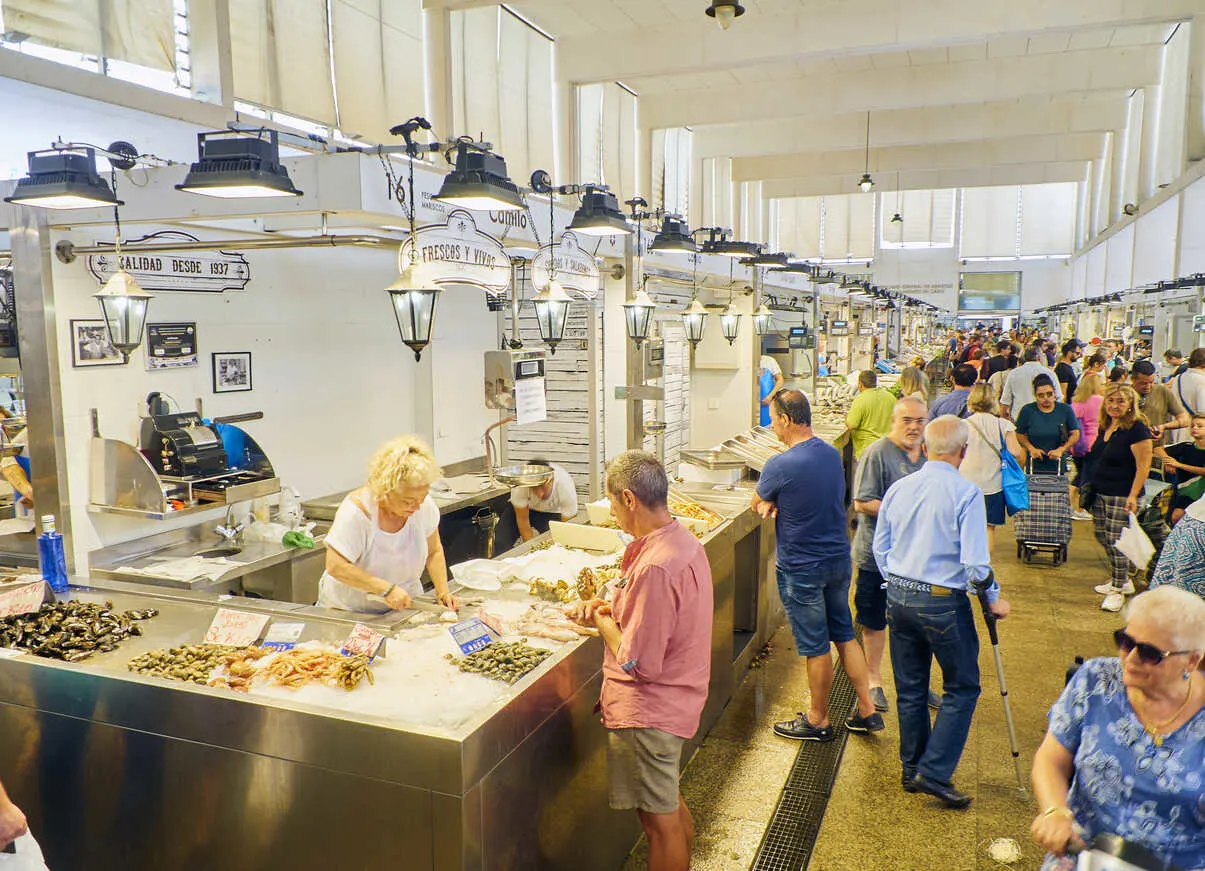
Beautifully Off the Beaten Path
What makes Cádiz such a hidden gem, particularly for North American expats, is how wonderfully under the radar it remains. Unlike Spain’s more famous cities, Cádiz hasn’t been overrun by tourists or expats chasing the buzz. Here, you can live comfortably on less than $2,000 a month for two people, making it an incredibly affordable option… one where you don’t have to sacrifice quality of life.
But Cádiz offers more than just a budget-friendly lifestyle. It’s steeped in rich culture—local festivals, flamenco rhythms, and centuries-old customs are part of everyday life. This makes it especially appealing to retirees and digital nomads looking for a slower pace and craving inspiration beyond the usual urban hubs.
Another undeniable advantage is its location. Cádiz is a small town with a relaxed, seaside vibe, but when you crave more action, dining, cultural events, or expat communities, larger cities like Seville and Jerez are just a short drive away.
What It Really Costs to Live in Cádiz
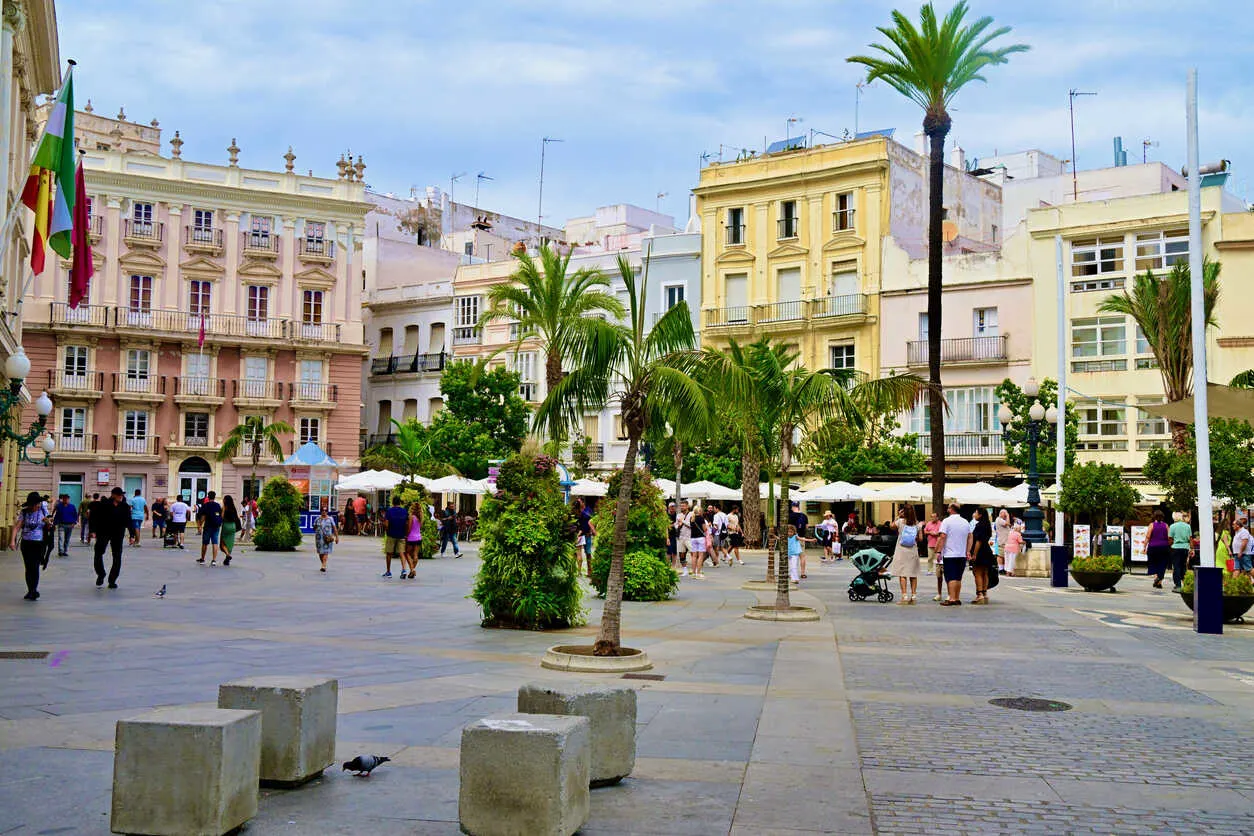
Compared to Spain’s bigger cities, housing in Cádiz remains quite accessible. The peninsula location restricts new construction, making homes a sought-after commodity. And renovating older buildings can be expensive due to strict preservation rules—but overall, property prices remain appealing compared to larger Spanish cities.
To get a better sense of the property market, I spoke with Domingo from Innysse. Smaller fixer-uppers start at roughly €275,000 ($320,119), similar to Málaga before prices surged, while newer two-bedroom flats in the old town usually begin near €400,000 ($465,628).
For rentals, you can still find renovated, unfurnished one- or two-bedroom apartments starting at about €850 monthly, though €1,000+ is becoming more common. With growing interest from European buyers, it’s expected that property costs will continue to rise in the coming years.
When it comes to food and groceries, prices are fair. My dinner at Casa Lazo, mentioned above, included garlic shrimp, seasoned potatoes, a whole sea bream for two, wine, and dessert, all for around €70. For a typical lunch experience, it’s a good idea to stop at Taberna Casa Manteca in the La Viña neighborhood.
Established in 1953, this iconic tavern is adorned with vintage memorabilia and is renowned for its traditional Andalusian tapas. You can’t go wrong with the famed tortillitas de camarones (crispy shrimp fritters), chicharrones especiales (thinly sliced pork belly with sea salt and lemon), and mojama (air-cured tuna). With tapas priced around €2-€4, you simply won’t break the bank when dining out.
For around $2,000 a month, a couple can live comfortably in Cádiz—and even enjoy a few extras. A renovated one- or two-bedroom apartment in the historic center starts at about $950 a month. Basic utilities (electricity, water, gas, and internet) run roughly $135 to $210 a month. Cellphone plans start as low as $25 per month per person.
Private health insurance for expats typically ranges from $70 to $170 a month depending on age and coverage, with most routine visits costing little to nothing out of pocket. Even with transportation, such as a monthly round-trip train to Seville ($38), you’ll still have room in your budget for tapas, cultural outings, and the occasional day trip.
What Healthcare Dreams Are Made of
Have you ever experienced the rare sensation of reverse sticker shock? I did, when I first moved to Madrid. If you’re an American, the quality and affordability of Spanish healthcare can feel almost too good to be true. Healthcare is hands-down one of the biggest perks of living in Spain. Access to public and private care is both affordable and high quality.
Cádiz itself has a few local clinics and public health centers that cover most day-to-day needs, but for more specialized care or larger hospitals, residents often travel to nearby Jerez de la Frontera or Seville. Both cities are home to well-equipped public hospitals and a range of private medical centers. For most people, especially retirees or expats applying for residency visas, private insurance is required and the way to go as it offers faster appointments and access to English-speaking doctors.
Gidea–Insbrok (sign up with my affiliate link) is a highly recommended insurance broker that works specifically with expats in Spain. The company makes it easy to compare plans that meet visa requirements, whether you’re applying for a non-lucrative visa, digital nomad visa, or something else entirely. Through their platform, you can get quotes from Spain’s top private providers like Sanitas, Adeslas, Asisa, and DKV. Since it’s a brokerage, rates are often better than what you’ll find going direct.
Private health insurance plans generally range from €60-€150 a month, depending on your age and coverage needs, and many come with low or no copays. For something as routine as a dermatologist visit or physical therapy session, it’s not uncommon to pay under €100 out of pocket when seeing a provider out of network.
Who Will Thrive in Cádiz (and Who Might Not)
Cádiz has a quiet magic to it, but it’s not for everyone.
This is a city for those who crave authenticity over convenience. It’s best suited to the curious and adaptable, the kinds of people who get excited about diving into a new language, embracing local rhythms, and living where tradition still shapes daily life. If you’re looking for a place where you can live well on less, walk everywhere, and feel like part of a real community, Cádiz might just be your place.
That said, if you rely on nonstop flights, big-city energy, or want a built-in English-speaking expat network, Cádiz may feel a bit too out of the way.
Journey to the Edge of Spain (It’s Worth It)
Unlike Málaga, Valencia, or Barcelona, it takes a bit more effort to get to Cádiz, which helps keep the crowds away. The nearest airport is in Jerez de la Frontera, about 30 minutes by car, while Seville Airport is larger and around an hour and 15 minutes away. There are regular trains and buses to Seville and Madrid.
Once you arrive, Cádiz is a dream for anyone hoping to live car-free. The city is flat and compact, making it easy to explore on foot. (I was able to walk from one side of the city to the other in about 20 minutes!) Just note that the cobblestone streets in Old Town can be tough if you have mobility issues.
There’s also a growing bike culture, and a breezy passenger ferry connects Cádiz to El Puerto de Santa María across the bay, perfect for a day trip of tapas and sherry tastings. Local buses cover most neighborhoods, though public transit is somewhat limited compared to bigger cities.
If you’re planning a scouting trip, skip the rental car and stay in the historic center to get a real feel for daily life. That said, if you want to explore the wider province having a car helps. Rentals are affordable (I paid just $150 for four days), and driving through the Cádiz countryside is part of the experience.
Planning Your Scouting Trip
A visit is the best way to get a feel for daily life before making the leap. Base yourself in the historic center where you’ll be walkable to the beach, market, and local cafés. Vacation rentals and boutique guesthouses offer a great introduction to the local lifestyle without sacrificing comfort. I recommend coming for at least two weeks, but a month or longer is best to truly get a sense of the rhythm and routine. For a longer stay, choose one of the following neighborhoods and experience the most authentic Cádiz lifestyle.
Get Your Free Spain Report Today!
Get Your Free Spain Report Today!
Learn more about the lower cost of living in Spain and other countries in our free daily postcard e-letter. Simply enter your email address below and we'll also send you a FREE REPORT — Live the Good Life in Sunny, Affordable Spain.

By submitting your email address, you will receive a free subscription to IL Postcards, The Untourist Daily and special offers from International Living and our affiliates. You can unsubscribe at any time, and we encourage you to read more about our Privacy Policy.
Where to Live: Palm-lined Streets and Flamenco
El Pópulo: The oldest neighborhood in Cádiz, El Pópulo is perfect for history lovers. Picture narrow cobblestone streets, Roman ruins, and ancient archways—it’s like walking through a living museum. The area is filled with landmarks like the Roman Theater, Cádiz Cathedral, and Arco del Pópulo. I loved getting lost here, then stumbling upon a historic pastry shop from the 1800s, Confiteria el Populo. Here you can find renovated apartments inside centuries-old buildings. Noise can be an issue—especially in summer when the area fills with tourists. Parking is next to impossible, many streets are pedestrian-only, so you’ll likely need to use public garages or park farther out.
La Viña: If you want local flavor and lively street life, La Viña is your barrio. This working-class neighborhood has lots of color and character, where everyday life spills out onto the streets. In this corner of Cádiz, friendly neighbors know each other and the energy kicks up during Carnival, which basically started here. It’s also home to Playa de la Caleta, a small but iconic beach where I caught a colorful sunset before wandering the palm-tree-lined pedestrian street, calle la Palma. The area’s personality is a big plus, but if you’re looking for peace and quiet, La Viña might not be your best match. Parking is also a struggle, so this one’s best for folks who want to live car-free in the heart of it all.
Santa María: With deep flamenco roots and a down-to-earth feel, Santa María is known as the cradle of flamenco in Cádiz, and you’ll still hear strains of guitar and song drifting out of open windows. While some buildings are in need of repair, this area is slowly changing, creative spaces are popping up, and there’s a growing community of artists and students. This neighborhood is a bit rougher around the edges and still finding its way between tradition and change. Located in the old town as well, parking is hard to come by.
El Mentidero: Quiet, residential, and easy to fall in love with, El Mentidero is located just north of the old town, it’s close enough to walk everywhere, and has a mix of historic and contemporary architecture. You’ll find leafy plazas like Plaza del Mentidero and Plaza San Antonio, plus Parque Genovés—a historic garden going back to the 1800s. I almost stayed at the ultra-modern Parador de Cádiz located right on the Atlantic, but opted for the historic center, and passed by daily during my stay and noticed how calm and neighborly it felt. The Mentidero is a great choice if you want central living without the late-night noise. Parking is slightly easier to find here.
Bahía Blanca: Just outside the old town, Bahía Blanca is a more modern, residential neighborhood with green spaces and easy access to both the beach and transportation (you’re close to the train and bus stations). It’s actually one of the most expensive and sought-after areas in Cádiz, with condos ranging from €400,000 ($465,610) to €1,000,000 ($1,164,025). I wandered through Bahía Blanca on my way to Santa María del Mar beach and the historic feel of the old town slowly gave way to a more contemporary vibe. Housing here is usually newer and more spacious—though prices will reflect that. If you want modern comforts, fewer tourists, easy beach access, and the possibly of a building with parking, Bahía Blanca is worth checking out.
I stayed in a historic home that’s been transformed into a boutique hotel called Áurea Casa Palacio Sagasta, a beautifully restored Baroque mansion from the mid-18th century. I spent afternoons sipping cava (Spain’s version of Champagne) in the central courtyard, which now serves as the lobby, beneath a glass-and-iron rooftop and in front of the grand imperial staircase built in 1860. The hotel is located in the heart of Cádiz’s old town, on a quiet stretch of one of its main historic streets. Perfect for wandering out into the maze of cobbled stone streets scattered with tapas bars, family-run shops, and traditional restaurants.
(Another gem is Casa Cánovas, with its lavish design and old-world charm.)
If you’re considering a move to Cádiz, set aside time on your scouting trip to talk to real estate agents and get information on deposits, rental contracts, what’s included in the price, how quickly inventory moves, and pet policies. Wandering around your desired neighborhoods is essential so you can get a sense for amenities such as supermarkets, parks, and clinics. Get your hair cut, go to a gym, ask for your medication at a pharmacy, and if you’re feeling adventurous, get your teeth cleaned—these activities will give you a feel for life here.
Spring (April–June) and fall (late September–November) are ideal times to visit for good weather. You’ll skip the summer crowds and stifling heat, but still enjoy long, sunny days perfect for exploring. (Summer can get busy, especially with Spanish holidaymakers, while winter, though mild, is quieter and less vibrant.)
Over the years, I’ve been lucky to see more than just Cadiz, so I encourage you to use Cádiz as your home base to explore the surrounding gems of the province; each side trip will feel like stepping into a different world. Take a quick train ride to Jerez de la Frontera and sample the local sherry at Bodegas Fundador, the oldest bodega in town, dating back to 1730. I tried a nutty, amber-colored oloroso and a sweet, rich Pedro Ximénez that tasted like dessert in a glass. If you’re up for something more unique, catch an equestrian ballet (yes, that’s a thing!) at the Royal Andalusian School of Equestrian Art. I went in 2007 and let me tell you, seeing Spanish horses dancing to flamenco music is not something you ever forget.
Or head to the hilltop town of Vejer de la Frontera, about an hour away by car or bus. One of Andalucía’s famous pueblos blancos, wander the ancient whitewashed walls, constructed in the 11th-15th century, that are covered with potted plants and winding streets that blend Moorish and Christian architecture. Don’t leave without taking a photo in the old Jewish quarter at the Arco de la Monjas (Arch of the Nuns) for a stunning view of the town framed by the arches.
And if it’s beach vibes you’re after, Tarifa is just an hour’s drive and absolutely worth it. It’s the kite-surfing capital of Europe so the winds are no joke, but with endless white sands and the laid-back, boho energy of the town, it’s the kind of place that makes you want to stay longer. This whole corner of Spain is full of Andalucian delights.
Worth the Drive: Zahara de los Atunes & Bolonia Beaches
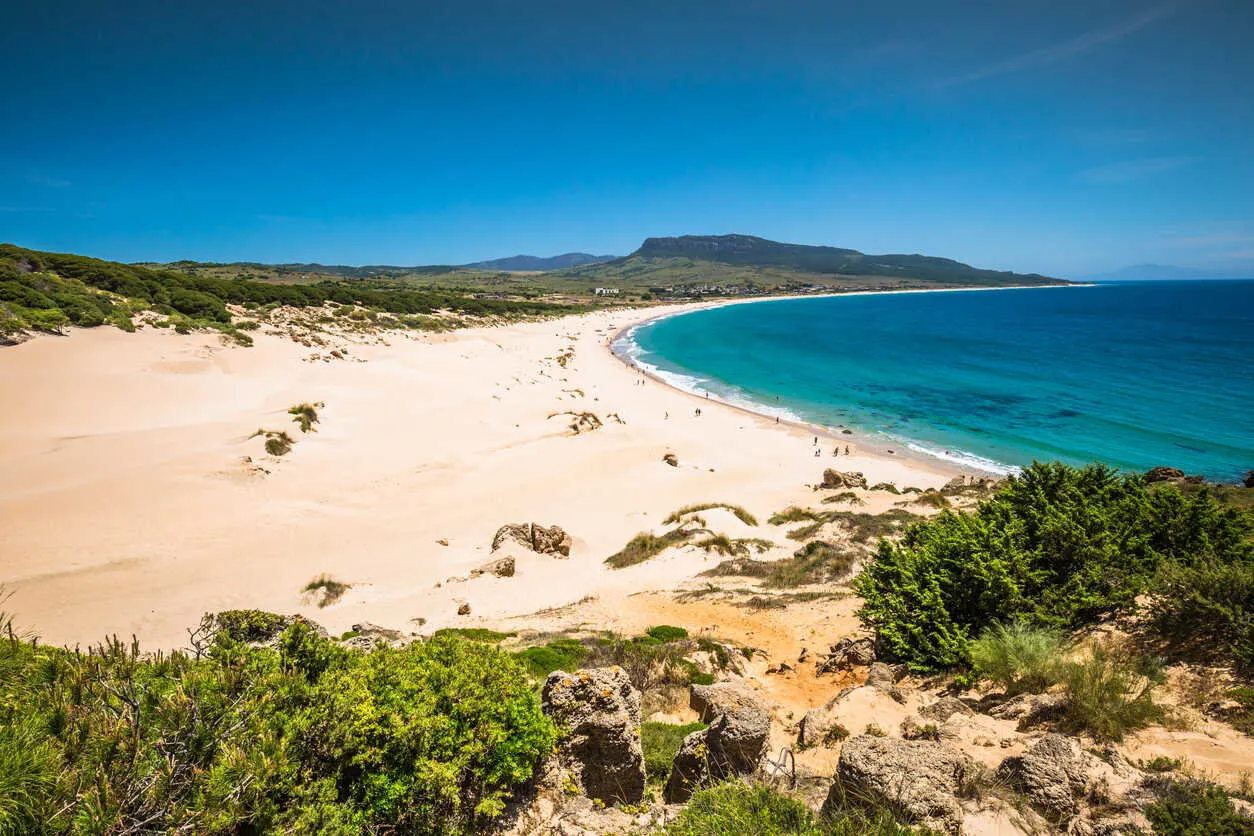
If you’ve got a car and a free afternoon, the beaches of Zahara de los Atunes and Bolonia are well worth the one-hour drive from Cádiz (they’re also just 30 minutes apart).
Zahara is a charming whitewashed town known for tuna, specifically the prized Atlantic bluefin tuna. I stopped there on a caravan trip from Malaga in 2022 to eat at Trasteo, a Michelin Guide recommendation, famous for its creative bluefin tuna dishes.
I didn’t have time to see the beaches, but they’re known for miles of golden sand and a laid-back vibe. Bolonia beach, on the other hand, I did get to visit—and I’m still dreaming about it. Just outside Tarifa, this wild beach is all white, powdery sand and turquoise water that looks like the Caribbean. But don’t be fooled, it’s the Atlantic, which means it’s cold! Refreshing on a hot summer day.
No crowds, no lounge chairs or built-up boardwalks, just sand dunes, calm water, a few rustic chiringuitos—what Spaniards call open-air restaurants on the beach—and a whole lot of peace and quiet.
Bolonia is one of my favorite beaches in Spain, hands down.
A City That Stays With You
Returning to Cádiz after all these years, I finally understand what kept calling me back. It’s not just the stunning coastline or the pastel hues of its historic streets, it’s the quiet pulse of daily life here, the deep-rooted culture that hasn’t been diluted by overdevelopment, and the warmth of a community that still feels truly local. If any place can preserve its unique soul amid change, it’s Cádiz.
As tourism continues to grow across Spain, this city feels like a quiet sanctuary. Living here as an expat means embracing a slower pace, discovering hidden corners, and becoming part of a town that values authenticity. While it may not offer the nonstop buzz of a big city, what Cádiz lacks in size it more than makes up for in affordability, and that unmistakable Andalusian spirit.
Get Your Free Spain Report Today!
Get Your Free Spain Report Today!
Learn more about the lower cost of living in Spain and other countries in our free daily postcard e-letter. Simply enter your email address below and we'll also send you a FREE REPORT — Live the Good Life in Sunny, Affordable Spain.

By submitting your email address, you will receive a free subscription to IL Postcards, The Untourist Daily and special offers from International Living and our affiliates. You can unsubscribe at any time, and we encourage you to read more about our Privacy Policy.
